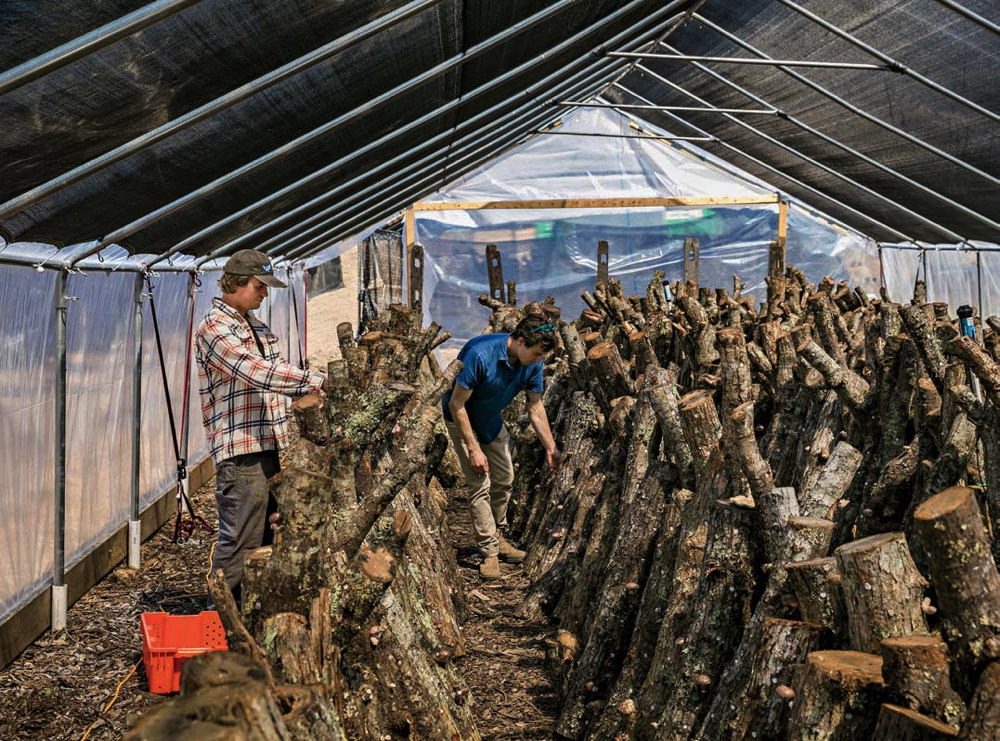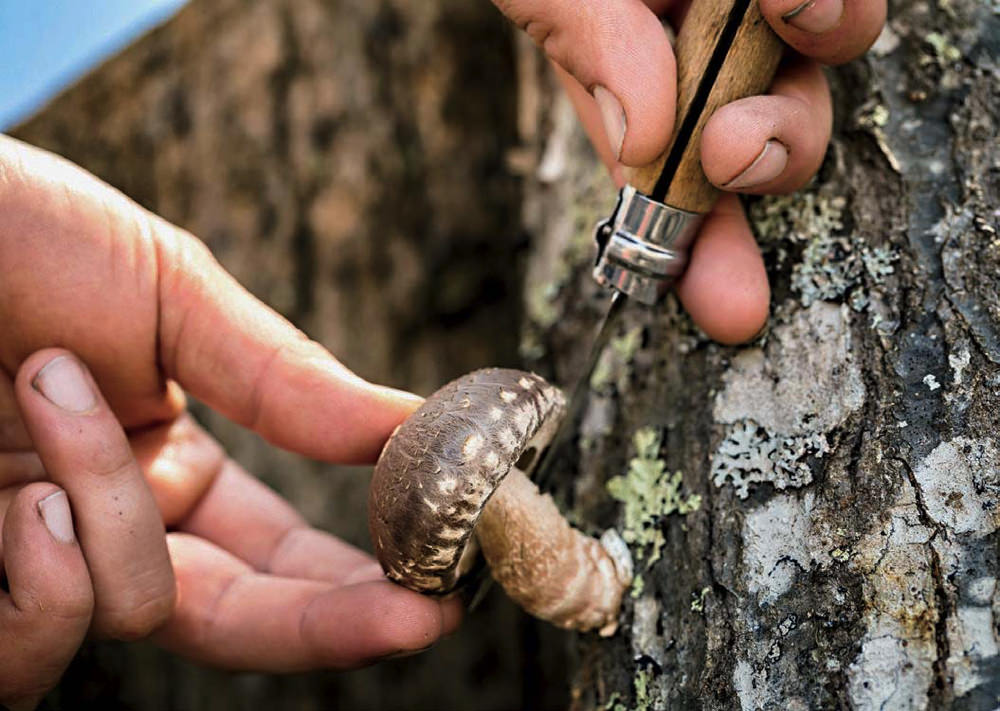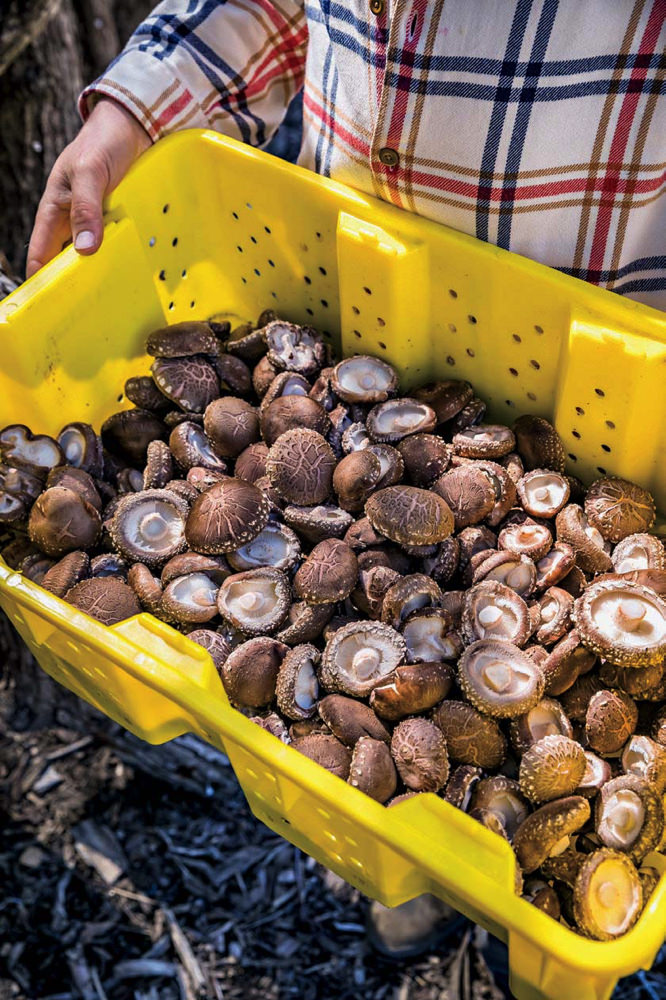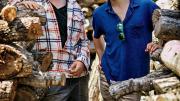On the western side of Martha’s Vineyard, a dirt road winds past secluded summer homes with ocean views and then dead-ends at an eerie sight: 45,000 oak logs stacked in crosshatch formations under a canopy of trees. In the nearby lot, young men with chainsaws and a Bobcat are cutting felled trees and piling up more logs, while inside a passive-solar-fueled greenhouse, Tucker Pforzheimer ’13 inspects the latest fruits of these labors.
“Put your finger right there,” he says. “Do you feel the gill? And you feel the end is curled? That’s a pretty perfect cap. You should take a bite.” He slices off the firm, nutritious shiitake that in five weeks has grown to the size of a doorknob, and hands it over. “It’s kind of special having it off the log.”
And it really is. The flavor—an earthy nuttiness laced with garlic—is surprisingly rich, almost creamy. The mushroom is chewable, with a springy texture resembling meat. That’s part of the plan, too. “What we’re doing,” Pforzheimer says of MV Mycological, which he runs with business partner and friend Truman French ’13, “is replicating as closely as we can the wild environment of a shiitake, to bring you a product that tastes like it would if you had gathered it in the forests of East Asia, as opposed to a very generic, watered-down version of this great mushroom that is basically all that everybody knows in the U.S.”

Tending to shiitakes during the “fruiting” cycle in a solar-powered greenhouse
Photograph by Randi Baird Photography
The young entrepreneurs actually met in Organismic and Evolutionary Biology (OEB) 54: “Biology of Fungus,” taught by Gray professor of systematic botany Donald H. Pfister. Although unaware that these “very engaging personalities” would soon be operating a mushroom farm, Pfister recalls that they did appear to be “hatching a plan” based on an interest in “fungi that was more than academic.” With more than 2,300 known edible species, fungi are an “underappreciated” source of sustenance, he adds, and it’s “admirable that they are looking to make them more prominent in the American diet.”
Pforzheimer concentrated in OEB, and French studied economics, but both had shared similar experiences in South America during college. French witnessed deforestation for crops and expanded cattle ranching in the Brazil Atlantic Forest, and Pforzheimer saw the wholesale burning of Andean climax forest in Argentina while working for eight seasons as a guide for a fly-fishing outfitter. That destruction, he says, was accelerated by tariff easements that allowed more South American beef to be exported to the United States and China. “For weeks the cordillera would be shrouded in thick black smoke, only to reveal blackened mountains when it cleared,” he reports. “This is not the fault of those seeking to make a living: it’s the fault of those demanding beef.” Curious about starting a business, they wanted to promote “an alternative source of protein” more aligned with their environmental values, says French, a lifelong vegetarian. And soy-based, industrially processed “vegan meat” is not the answer either, Pforzheimer asserts, fearing the emphasis on soy production will lead to more destruction in the Amazon and elsewhere. “We should simply be eating more plants.”
Mushrooms seemed a viable option because they could grow well in the cool, maritime climes and high seasonal humidity of Martha’s Vineyard where French was born and raised and had access to leased land. An initial “get-rich-quick scheme” to develop a truffière, according to Pforzheimer, also prompted French to experiment with injecting shiitake spawn into oak logs left over from work done by his landscaping and construction company.
The spawn (live active fungus, versus spores) took root in the logs—spreading white, branching threads of mycelium, the vegetative part of the fungus—and by the fall of 2014 had fruited into “the nicest shiitakes we’d ever seen,” says Pforzheimer, who learned about the food industry from his father, chef and restaurateur C. Andrew Pforzheimer ’83. (He and other family members have been notable Harvard supporters, as in the eponymous undergraduate House.) The younger Pforzheimer shopped this debut crop to Vineyard chefs, who were impressed enough to persuade him to leave Manhattan, where he worked at the food-industry software and analytics company Avero, and move to the island in 2015.
Now in its fourth full season, MV Mycological is producing 600 to 1,000 pounds of fiber- and nutrient-rich shiitakes a week from April through December. Grown outdoors, using traditional Japanese techniques and no fungicides or pesticides, the mushrooms require significant manual labor from the company’s four employees, but only a fraction of the land, water, and other resources required for meat production. Moreover, French says, their restorative agricultural system relies entirely on oak logs salvaged as waste products from a local gravel and mining company, or from conservation groups intent on reclaiming the island’s sand plain by removing newer-growth trees.
With 30,000 logs rotated in batches that fruit each week, some shiitakes are sold at a few island retailers and a local farmer’s market. But most go to 50 restaurant clients, including Sorellina, Pammy’s Field & Vine, and O Ya, in Greater Boston, and to a distributor who supplies around 20 chefs in Manhattan. On the table now is a potential deal with Dig Inn, a chain of locally farm-sourced restaurants, to help supply its Boston and New York kitchens. “That will allow us to build a larger farm just for them,” Pforzheimer explains. “Part of building this brand has been to really differentiate ourselves as a premium mushroom option. We know the market is there. The whole industry is ripe for disruption.”
For centuries, wild shiitakes were found and collected only on decaying wood in Japanese forests; take means mushroom, and shi refers to the Castanopsis cuspidata tree. But since the early 1970s, when the U.S. Department of Agriculture (USDA) opened the door to shiitake spawn imports, prompting the spread of farming technology, shiitake production has soared in the United States and around the globe. The volume of fresh mushrooms, used as food and in medicines, topped 2,109 tons in 2017, according to a Market Research Future report, and is predicted to more than double by 2023. In the United States, “specialty mushroom growers” (of shiitakes, oysters, and other exotics) generated $96.2 million in sales for 2016-2017, according to a report by the USDA’s National Agricultural Statistics Service; the 182 shiitake growers (those with at least 200 natural wood logs in production or commercial indoor growing space) brought to market 10.5 million pounds that generated $41 million.

Slicing a nutrient-rich shiitake fresh off a log
Photograph by Randi Baird Photography
But shiitakes (Lentinula edodes) still lag behind white button, crimini, and portobello mushroom crops (cultivars of Agaricus bisporus). All of these mushrooms, along with the widely produced oyster variety, grow by decomposing dead plant matter, Pforzheimer notes, unlike morels, chanterelles, porcinis, and truffles, which “live mutualistically with a living tree or plant.” The majority of commercially produced shiitakes, therefore, are raised inside plastic bags. They feed on substrates like sawdust and manure, in climate-controlled warehouses where various horticultural methods can expedite the fruiting process and modulate volume and appearance.
Companies in the Netherlands, Kosovo, France, Japan, and increasingly in the Middle East and Africa, produce large volumes of shiitakes, and are major exporters, but, as a group, Asia-Pacific growers generate the bulk of the world’s shiitakes. China leads the pack, and its growers are also exporting shiitake spawn, promoting sales to U.S. growers, retailers, and distributors, according to recent industry reports. Some current and former major U.S. producers, already squeezed in Pennsylvania, for example, by acute labor shortages, say the Chinese spawn—far cheaper, despite being imported at major expense in frozen logs—are undercutting their businesses. Just as concerning, they add, is that the fruited shiitakes are then sold as “Made in USA,” even though the spawn is already a complete form, akin to a tomato seedling.
Pforzheimer says he has received several emails from Chinese “log manufacturers” himself, urging him to switch. But, in general, he explains, one of the main problems is the lack of “USDA regulation specific to the mushroom industry in this country, [which means] that the spawn blocks or logs can be made of, literally, anything. Many are marketed as ‘oakwood shiitakes,’ dissembling the reality that, at most, they are grown on media containing oak chips. Because mushrooms absorb and concentrate whatever they grow on, this lax regulation of growth media is a health problem.”
For obvious reasons related to erratic temperatures and the nature of live cultures, wild-harvested organic shiitakes are far harder to grow—at least consistently—than those nurtured by an HVAC system. But they do thrive on the Vineyard. French learned years ago, through his landscape work and through projects with his father, the stone mason-artist Lew French, about the constant battle against moisture, viruses, and fungi waged by those who want fruit orchards. “We have 95 percent humidity in the summer. What doesn’t like humidity? Apples, cherries, peaches,” he says. “But with shiitakes, we don’t have to fight it, and we’re getting eight months of production—what crop here gets that? This year, with the addition of the solar greenhouse, we’re likely to get 10.”

Harvesting crops bound for New York and Boston restaurants
Photograph by Randi Baird Photography
And because of how they are grown, MV Mycological’s shiitakes contain double the amount of fiber found in factory-produced specimens. “Again, it’s common sense,” Pforzheimer says. “Where are they getting the fiber from?” He gestures across the thousands of vertically upended logs in the greenhouse tent where the shiitake spawn have been feasting on cellulose, sugar, and moisture and are currently fruiting. Shiitakes and other mushrooms are already a primary source of protein and used in health practices in Pacific Rim countries, and nutritional testing has shown that MV Mycological’s shiitakes also hold significantly more protein—2 grams per about four mushrooms—than typical store-bought varieties. That’s no match for the average 18 grams of protein packed into a three-ounce serving of ground beef—but, Pforzheimer argues, “gram for gram,” shiitakes are a healthier, more sustainable source: “One gram of shiitake protein requires about one-seventieth of the water and one-thirtieth of the land to produce.” Moreover, shiitakes are high in lentinan, a type of sugar molecule found, in some U.S. laboratory studies, to bolster the immune system and possibly aid the cancer-fighting process. Shiitakes are also rich in B vitamins, copper, manganese, zinc, selenium, potassium, and other immune-boosting elements. That garlicky flavor? It’s a sulfur compound—the same one found in allium, Pforzheimer adds, which oak-grown shiitakes synthesize. And because these shiitakes have always absorbed natural light and, like humans, tan, they are high in vitamin D.
But all of that fiber and nutrient-absorption takes a lot of time. At MV Mycological, the cycle from spawn to first fruiting is at least 18 months. For a good year of that period, the freshly inoculated logs, manually “crib-stacked” in those crosshatch formations, just sit in the woods.
The cultivation process starts with spawn that Pforzheimer and French purchase from a company run by two University of Wisconsin-trained mycologists who import slants—“small vials of pure mycelium, which looks kind of like cotton in a tube”—from Japan and then propagate it on a mixture of grain and sawdust in five-pound bags, Pforzheimer explains. “The sawdust-mycelium suspension is kind of like an egg for a developing chicken fetus—we inoculate it into logs, and it contains the starter nutrients necessary for the mycelium to migrate from the inoculation site into the log.”
Each spring and fall a new batch of fresh-cut oak logs is quickly injected with the spawn (to prevent any other micro-organisms from infiltrating the wood). The roughly 30 injection sites per log are then plugged with plastic caps—and the mycelium at each site starts colonizing immediately. Unlike plants, mushrooms are not photosynthesizing, but respirating, Pforzheimer explains: “They breathe oxygen and exhale carbon dioxide. All their carbon comes from what they eat, with all the attached minerals and vitamins therein.”
Because the mushroom itself is the reproductive body of the fungus, it carries the spores, and each fruiting is an effort to propagate. “Fungi manage their growth via turgor pressure,” Pforzheimer continues. “Imagine a very thin water balloon. As each individual mycelial thread, or hypha, absorbs water, it forces its tip between the cells of its growth medium and metabolizes the nutrients in those cells to fuel itself. And when the fungus begins to form mushrooms, it aggregates many hyphae, which force their way out of the growth medium into the air and form the mushroom. It’s certainly a biological wonder!”
Logs that are ready for fruiting are soaked by groups in a dumpster-size vat of water and transferred to the greenhouse, says French, who runs the farm’s complex logistical operations alongside the company’s only other employees, Pforzheimer’s younger brothers Jack and Ross. The immersion helps induce fruiting, which takes five or six weeks. “On average, each log produces eight to 12 mushrooms per fruiting time at five times a year, for three years,” French says. The farm processes more than 10,000 logs a year from its 45,000-log inventory, with a late-winter break.
French works on the island full-time, but Pforzheimer, as business developer, also travels in New York and New England. “While it’s frustrating for this whole plant-forward dietary shift not to happen overnight, it’s gratifying to know that I can make a living trying,” he says, “even when I’m waking up at four to catch the first boat off island.”
The business relies on their uncannily complementary skill sets. Pforzheimer’s salesmanship is grounded in his passion for mycology and knowledge of the daily pressures of the restaurant industry. French has contacts, like the family friends who lease the company its 4.5 acres, and understands how business gets done on an island, where anything not produced on site is prohibitively expense to import and bartering services among tradespeople is the norm.
“We’re not buying grain and growing pigs on it. We’re taking waste products and producing protein.”
Farming was never French’s plan. “I thought I’d become an investment banker,” he says, “truth be told.” Business school is still not out of the question, but growing mushrooms makes sense to him now. He hails from Minnesota farming families, and has worked outside with plants, rocks, and earth his whole life. His vegetarian parents raised him that way, primarily because they grew up around slaughterhouses. It was the travels in Brazil, where his father owns farmland, along with his Harvard economics classes, that pushed him to evaluate the impact of many global businesses—mining, fossil fuels, commodity agriculture—on the “long-term health of society.” Ethical considerations aside, he adds, the inefficiencies and environmental degradation wrought by industrial-meat production don’t make sense, and the shiitake alternative does: “We’re not buying grain and growing pigs on it. We’re taking waste products and producing protein.”
He and Pforzheimer have mulled replicating scalable models of their operations elsewhere in New England—among other ideas. After six years of hard work, they both still appreciate the creative autonomy their business provides, but that giddy flush of excitement over starting an uncharted venture has waned. Entrepreneurship is like a dream that “becomes a nightmare pretty quickly—and then it becomes a dream again,” French says, laughing. “There are many iterations.” What is continually gratifying, however, is seeing evidence of all that a handful of brown fungus can achieve: “When people start to have the epiphany that their choices can drive a market—that their consumption patterns can actually cause change.”







